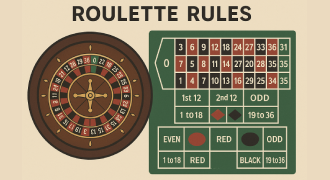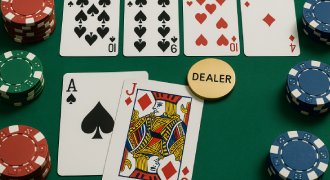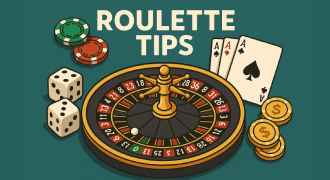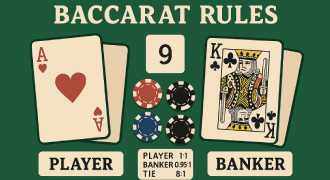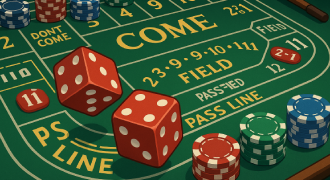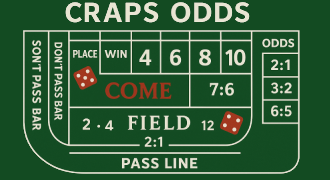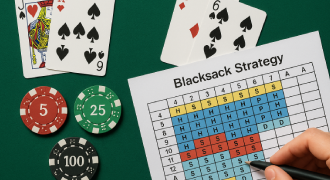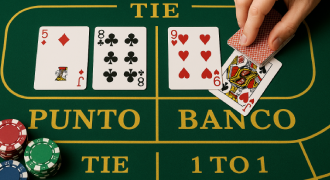Baccarat Strategy – Top Methods to Improve Your Winning Chances
Baccarat is one of the most popular casino games worldwide, valued for its simple rules and fast pace. Yet, while luck drives each hand, applying the right Baccarat strategy can help you stretch your bankroll, reduce risk, and maximize winning opportunities.
From smart bankroll management to understanding when to back the banker or player, strategies give structure to what many see as pure chance. By learning the top methods, you can approach every round with more confidence, discipline, and a sharper edge.
The Importance of Strategy in Baccarat
Baccarat is simple by design: you choose Player, Banker, or Tie; then the drawing rules decide the rest. Because there’s no mid-hand choice, some newcomers wonder, is there any strategy to baccarat? The answer is yes—if you define strategy as the way you select bets, size stakes, choose tables, and manage time. Those choices don’t change card order, but they do shape your results session by session.
Think of a baccarat casino game strategy as three layers working together. First, the basics: understanding house edge, payouts, and commission notes. Second, the betting layer: picking a main outcome (often Banker or Player) and deciding how you’ll handle streaks without chasing. Third, the session layer: limits, pauses, and a cooldown rule that protects your bankroll and your focus. Combine these and you have a steady baccarat game strategy you can repeat calmly from one shoe to the next.
Can a Real Strategy Help You Win Baccarat?
A steady plan can’t force a result, but it can reduce errors that drain chips over time. That’s why we encourage routine: select a table with rules you understand, favor the outcomes with better long-run math, and keep your units consistent. When people talk about a winning baccarat strategy or a winning strategy, what they really mean is a repeatable method that avoids tilt and respects small edges.
Here’s the simple reality we share with regulars: you control pace, selection, and stake size. We handle the dealing and auditing. Meet us halfway with structure and you’ll feel the difference—less noise, fewer impulse bets, and a clearer read on your session.
Widely Used Baccarat Betting Systems
Systems arrange your stakes from hand to hand. They don’t change the odds, but they can change how your bankroll rides the ups and downs of the shoe. Treat any baccarat betting strategy as a tool, not a promise. If a system asks you to stake more than your limits allow, it’s not a fit for this session—close the loop and step back.
We’ll outline the systems you’ll hear about most often. Keep notes, try them in low-limit rooms or free modes, and settle on the rhythm that makes you most comfortable.
The Martingale Approach
Martingale doubles the stake after each loss and resets to the base unit after a win. The goal is to recoup prior losses and book one unit of profit when the win arrives. It feels elegant on paper, but it runs into table limits and bankroll strain quickly during cold streaks.
- Pros: Simple to remember; easy reset after a win.
- Cons: Exponential growth collides with table caps; risk of a big drawdown.
- When to try: Only at very low units with strict stop rules.
The Paroli Method
Paroli flips the script: you press after wins (often for two or three steps) and drop back to the base unit after any loss. It’s a positive-progression system built to ride short hot streaks while limiting damage during chop.
- Pros: Contains risk during cold stretches; excitement without large exposure.
- Cons: Requires discipline to stop pressing; gains can vanish if you press one step too far.
- Best fit: Players who enjoy momentum but want capped exposure.
Fibonacci Progression
This progression uses the Fibonacci sequence (1–1–2–3–5–8…) to step stakes after losses and move two steps back after a win. It grows slower than Martingale and can feel steadier, though it still climbs during losing runs.
- Pros: Slower escalation; easier on table caps than doubling.
- Cons: Still a negative progression; requires attention to steps.
- Tip: Prewrite your sequence for the session to avoid mid-shoe math.
The Labouchere System Explained
Labouchere sets a list of small numbers that add up to your target profit. You stake the sum of the first and last numbers; win, then cross them off; lose, then append the stake to the end. It’s flexible but can spiral if losses pile up.
- Pros: Customizable goals; psychological clarity as you cross numbers out.
- Cons: List can lengthen during bad spells; bookkeeping on the fly.
- Advice: Keep lists short; stop when the target is reached—no rewrite mid-shoe.
The 1-3-2-4 Betting Sequence
A short, positive progression: bet 1 unit; if you win, bet 3; if you win, bet 2; if you win, bet 4; any loss sends you back to 1. It’s popular because it locks some profit after the second and third wins.
- Pros: Clear steps; caps risk; quick reset.
- Cons: Streak-dependent; discipline required to restart at 1.
- Sweet spot: Calm tables where you focus on execution, not speed.
Picking the Best Baccarat Variant for Your Play Style
Not all tables play alike. Variations in commission rules, game speed, and layout mean your baccarat strategy should adapt to each setting. Consider these points as a quick “fit check” before taking your seat.
Punto Banco Strategy Tips
Punto Banco (the standard in most lobbies) uses fixed drawing rules and even-money payouts, with Banker often paying 1:1 less a small commission. A calm baccarat strategy here is to favor Banker slightly, size units conservatively, and treat Tie as an occasional accent. If the table is “no-commission” with a posted exception (such as Banker 6 paying half), read that note first; it subtly changes long-run returns.
Chemin de Fer Approaches
Chemin de Fer is rarer online but shows up in Europe and private rooms. A player banks the game; limited drawing choices exist (especially around five). The mood is social and strategic. Set modest targets, keep notes, and remember that etiquette is part of the experience. If you join a streamed version, expect slower pacing and savor it.
Adjusting for Mini Baccarat
Mini Baccarat compresses the layout and usually lowers limits. The draw chart remains the same, but rounds move faster. Keep your base unit small, breathe between hands, and resist pressing after a sudden swing. Mini tables are excellent places to test a sequence like 1-3-2-4 without stress.
Baccarat Banque Insights
In Banque, the bank can be held by a player for extended stretches. If you’re observing or seated, expect longer phases with the same banker and a more formal cadence. Treat your plan as a long set rather than a quick set; save energy, track your exposure, and don’t chase a banker’s streak with oversized stakes.
Banker or Player Bet – Which Offers Better Value?
Over many shoes, Banker edges Player by a small margin thanks to the order in which the two sides resolve third-card decisions. Classic tables rebalance that with a commission on Banker wins; no-commission formats use a posted exception instead. For a steady, low-effort plan, many guests make Banker their default and sprinkle Player for variety. Either way, keep Tie as a light garnish.
Your baccarat strategy doesn’t need to be complex. Pick one main lane, set a base unit, and promise yourself that you’ll pause after a fixed number of hands. That simple pledge prevents most spur-of-the-moment mistakes.
House Edge and Payouts Demystified
Understanding return math turns guesswork into clarity. We keep these figures on our rules panel, but here’s a snapshot you can reread on the way to your seat. It highlights the house edge for Banker, Player, and Tie, plus common side bets, so you can judge value quickly. Remember that exact percentages depend on decks, paytables, and special rules like a Banker-6 half-pay. Use the table below to compare options at a glance, align limits with your plan, and choose the wager mix that best fits your session goals.
Quick Reference: Baccarat Payouts
Below is a summary table that clearly shows the basic payout odds for the main outcomes and helps you quickly get your bearings before placing a bet.
|
Bet Type |
Typical Payout |
Notes |
|
Banker |
1:1 (commission may apply) |
Often best long-run math |
|
Player |
1:1 |
Simple settlement |
|
Tie |
8:1 (sometimes 9:1) |
Less frequent outcome |
|
Pairs (optional) |
11:1 (varies) |
Higher variance side bet |
House Edge Percentages by Bet Type
The table below summarizes the long-term statistical edge for each common baccarat bet, allowing you to compare risk and value at a glance.
|
Bet |
Approx. House Edge* |
What It Means |
|
Banker (classic commission) |
~1.06% |
Slight favorite in the long run |
|
Player |
~1.24% |
Close behind; even-money payout |
|
Tie (8:1) |
~14% |
High payout, low frequency |
*Edges vary with shoe size and specific table rules; always check the felt.
Is the Tie Bet Ever Worth Placing?
Tie is fun in small doses and can brighten a session when it hits. As a core plan, though, it’s hard to carry because of its edge. Our pit advice: keep Tie tiny, keep it occasional, and never let it replace your main bet selection.
How Commission Affects Returns
A 5% commission on Banker wins keeps returns fair and predictable. No-commission tables remove the fee but adjust one specific result (such as a Banker 6) to keep the math in line. Notice the rule on your felt—this is a perfect line for your personal strategy chart or baccarat strategy cheat sheet so you never forget which room you’re in.
Managing Your Bankroll and Play Sessions
We see the calmest sessions when guests arrive with a simple written plan. Print it, jot it on your phone, or memorize it—just make it real. Define your total budget, preferred table limits, and session length in advance, then decide whether side bets are allowed and in what size. Add a break schedule, a maximum number of shoes, and a hard exit condition. By committing upfront, you reduce impulsive decisions, keep pace steady, and protect your enjoyment across the entire visit.
- Set betting limits and stick to them
Choose a base unit (often 1–2% of your bankroll), a maximum number of units per hand, and a firm stop-loss. When you hit the stop, step away. That one habit protects everything else. Predefine a modest stop-win, avoid laddering after losses, and cap total exposure per shoe. If limits conflict with table minimums, move tables rather than stretch your plan. Record each hand in short notes. Simple tracking reinforces discipline, highlights creeping bet size, and gives you proof that your rules actually work. - Don’t let emotions dictate your bets
Tilt is real. If a shoe turns choppy, scale down or pause. Even the sharpest system fails when frustration starts choosing your chips. Watch for cues: rushed bets, doubled stakes, ignoring limits, or chasing a single result. When you notice them, breathe, sit out a hand, and revisit your plan. Remove side bets temporarily, reduce to your smallest unit, or switch to observation mode for a few shoes. Emotional control preserves bankroll, keeps decisions consistent, and prevents small dips becoming costly spirals. - Take breaks to avoid long losing streaks
Short intermissions reset focus and help you follow your plan. Use breaks to confirm limits, read the felt again, and review results without heat. Time them intentionally—every 20–30 minutes or at shoe changes—and step away from the layout. Hydrate, stretch, and scan your notes. Confirm remaining budget, unit size, and stop conditions. If fatigue rises, end the session gracefully. Fresh eyes improve card-total recognition, reduce errors entering bets, and keep pace measured. Well-timed pauses turn marathon play into sustainable, enjoyable sessions.
Baccarat Myths and Misunderstandings
- Does card counting actually work?
Counting has little traction here because cards are burned, multi-deck shoes are deep, and third-card decisions follow a fixed chart. It’s more productive to choose stable stakes and clear tables than to hunt for tiny composition shifts.
- Can betting trends be trusted?
Trend boards are popular, but past outcomes don’t force the next hand. Treat them as entertainment or a way to pace play, not as a predictive engine for a baccarat pattern strategy.
- Is baccarat purely a luck-based game?
The cards are, but your routine isn’t. You decide where to sit, what to stake, and when to stop. That’s why structure beats superstition.
- Is consistent winning possible?
You’ll experience runs both ways. Consistency comes from habits—table selection, stake control, and pacing—not from discovering a secret baccarat pattern strategy.
Practical Winning Tips
Keep your approach compact. Guests who thrive long-term use a small list they can follow under pressure. Here’s ours from the pit:
- Favor Banker or Player as your main lane; keep Tie small.
- Size stakes so one swing never breaks your plan.
- Confirm commission or exception notes on the felt.
- Use a progression only if it fits within your limits at every step.
If you’re hunting the best baccarat strategy, remember that the “best” is the one you can execute without strain. The truly best strategy is repeatable, calm, and compatible with table rules.
When in doubt, the baccarat best strategy to win is to protect your bankroll first and let entertainment, not urgency, set the pace.
Look for tables with fewer decks in play
Some rooms list deck count on the info panel. Fewer decks can nudge returns slightly and, more importantly, often signal a table with crisp procedures and focused dealing. Use that signal alongside limits and commission notes when choosing where to sit. This can indicate fewer shuffles, cleaner shoe management, and faster round resolution, which benefits clarity and pace. Cross-check with table traffic, minimums, side-bet availability, and dealer rotation schedules to align volatility, comfort, and speed with your session goals and bankroll.
Practice with free games before wagering real money
Our RNG rooms mirror live layouts, countdowns, and payout banners. Use them to test sequences like Paroli or 1-3-2-4, to rehearse unit sizing, and to build a feel for shoe rhythm. This is how to shape an online baccarat strategy you can trust before stepping into a live studio.
Practice also helps you learn comfort limits: how many hands per session you enjoy, how often to pause, and how to keep notes without breaking your flow. Bring those habits to live play and everything feels familiar from the first flip.
Use the best baccarat strategies to increase your chances of winning
Here’s a concise worksheet you can save. It won’t bend the math, but it will keep your choices tidy under pressure. Consider it your pocket baccarat strategy cheat sheet:
- Table check: Classic vs no-commission? Deck count? Tie payout?
- Main lane: Banker or Player? (Pick one and stick with it for a shoe.)
- Unit sizing: Base = 1–2% of bankroll; cap per hand = 3–4 units.
- Progression rule: Paroli (press after wins) or flat betting; no mid-shoe switches.
- Break cadence: Pause every 15–20 hands; review quietly.
If you like visuals, sketch your personal baccarat strategy chart with those five lines. Track them as a professional would: simple, neat, and consistent. Patterns you see on the tote board can be fun, but don’t mistake them for a guaranteed pattern strategy—use them only to pace your play. Anyone promising a “mechanical best strategy for baccarat” that never fails is selling fiction.
FAQ
Is card counting effective in baccarat?
Not in any dependable way. The shoe is deep, third-card logic is fixed, and burn procedures dilute tiny shifts. Counting can’t deliver a baccarat winning strategy here; selection and discipline can.
What strategy is considered best for baccarat?
The calm, flat-bet approach with Banker as the default (on classic commission tables) is the most widely recommended. Pair it with fixed limits and scheduled breaks. If you want momentum, use Paroli in small doses.
What’s the right way to manage my bankroll?
Set a base unit (1–2% of bankroll), a per-hand cap (3–4 units), and a firm session stop-loss. Write them down. That’s the backbone of any baccarat rules and strategy guide we publish.
Which betting system is easiest for beginners?
1-3-2-4 is short, clear, and forgiving. Use it with low limits while you learn pacing. If it feels distracting, switch to flat betting and track results in units rather than currency.
Do strategies change when playing live baccarat?
Only the pacing changes. Live rooms include camera angles, countdowns, and chat; RNG rooms are instant. Your plan—table choice, unit sizing, pause rules—stays the same.
What is the most frequent winning hand?
Banker edges Player in the long run due to how baccarat drawing rules resolve. Classic tables balance that with commission or exceptions, but the slight Banker advantage is why many plans start there.

